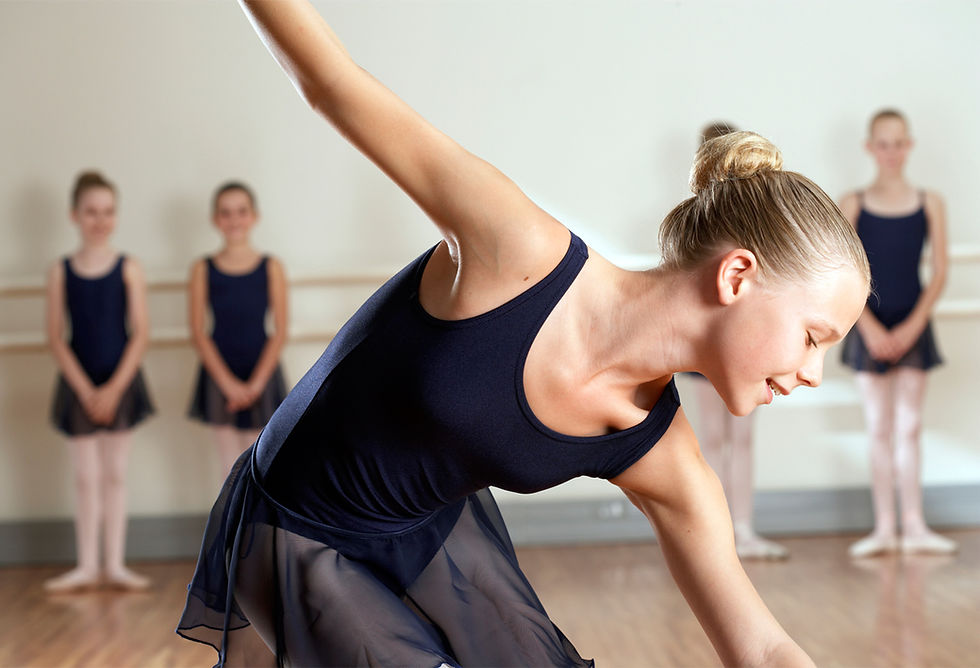When to Start Pointe
- Larysa Koehler
- Sep 4, 2018
- 3 min read
Updated: Jun 18, 2019
It is hard to tell an eager young dancer that she is not yet ready for pointe shoes. Students — and parents — must realize that teachers have to be firm: there is a risk of serious injury in introducing pointework too soon. Starting pointework is not just a question of age or physical maturity; readiness depends on strength, technique, attitude, and commitment.

The bones of the foot are not fully developed until sometime in the late teens or early twenties. Of course, there is a great deal of individual variation. If a young dancer attempts pointework without proper strength and technique, the significant forces created by the combination of body weight and momentum can permanently damage those not-fully-developed bones. Yet if a dancer is truly ready, if the introduction to pointework is gradual and always carefully and knowledgeably supervised, if the pointe shoes are well chosen and properly fitted, there is minimal risk of injury even if the bones are not fully formed.
Most dancers are ready to begin pointework between the ages of ten and twelve. Occasionally a supremely strong nine-year-old can safely go on pointe, but this is unusual. There is rarely any harm in waiting. A dancer who starts pointework a year later than her classmates almost always catches up. Many adult beginners are not ready for pointe either, but there is much less risk in their using pointe shoes because their feet have fully grown. In general, these are the criteria for readiness for pointe shoes:
Commitment
Most dancers need at least two to four years of training in ballet technique, with a good attendance record, before going on pointe. Other forms of dance, or classes that mix ballet with other forms, don’t count.
Someone who regularly takes several classes a week can probably start at a younger age than someone who attends less frequently. During the first year of pointe you will probably be expected to take at least three or four ballet classes a week (a minimum of 5 hours).
Maturity
Your demeanor shows that you have the maturity for pointework. Your attitude is attentive and hardworking, and your studio etiquette is exemplary.
Technique
Pointework requires a continual lifting up and out of the shoe. It’s the same strength and skill needed for attaining and sustaining a balance on high demi-pointe on one leg. That means that you can always hold your turnout when you dance, that your abdomen and lower back — your core — are strong, and that your legs, and especially your knees, are really pulled up.
You must be able to both relevé and piqué up to a balance. Calf and ankle strength are essential. Your relevé must be particularly strong; at least sixteen flawless ones onto a high demi-pointe center floor should be easy. You must demonstrate the correct use of plié in your dancing and know how to work your feet properly in tendu and all other exercises that require pointing the foot — no sickling.
Health and Physique
You should be in good health, not recovering from illness or injury, and of normal weight. You must possess the stamina to make it through a full ballet class several times a week. You don’t need insteps arched like bananas, but your feet must not be so flat or your ankles so stiff as to prevent you from properly “getting over” onto full pointe.
It’s the rare dancer who is not tremendously excited about going on pointe. It’s a good sign: an indifferent dancer may not have the perseverance needed for the repetitive exercises pointe training entails. But don’t let your enthusiasm tempt you to practice at home or to wear your new pointe shoes around the house. Proper supervision is so important that some schools require that their students keep their pointe shoes at the studio. And when you are ready to go on pointe, congratulations. You have worked hard for this moment.
Source: https://dancer.com
.png)



Comments